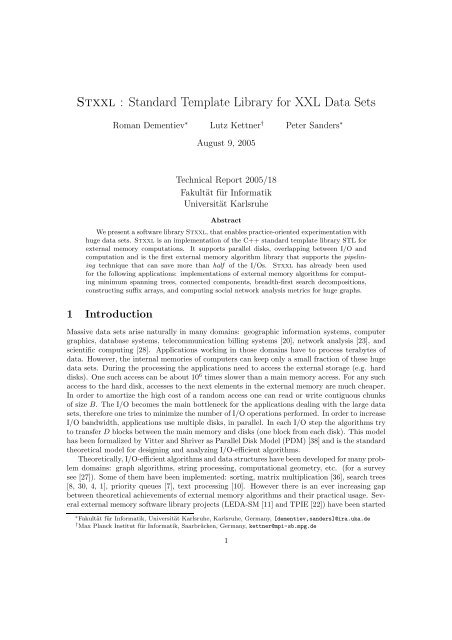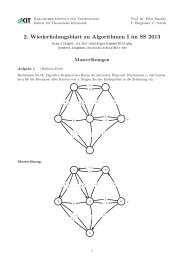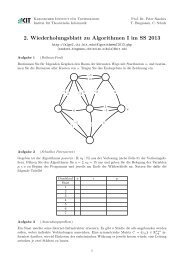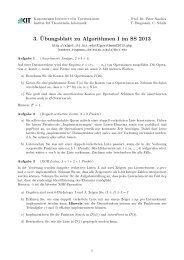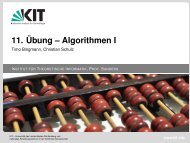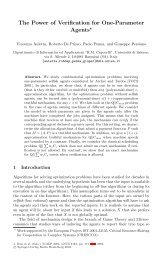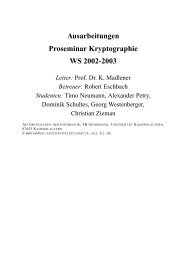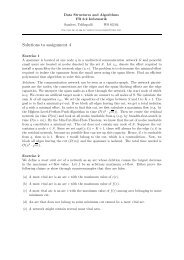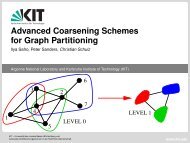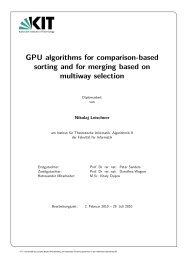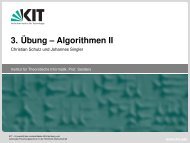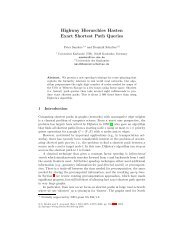Stxxl : Standard Template Library for XXL Data Sets - Max-Planck ...
Stxxl : Standard Template Library for XXL Data Sets - Max-Planck ...
Stxxl : Standard Template Library for XXL Data Sets - Max-Planck ...
Create successful ePaper yourself
Turn your PDF publications into a flip-book with our unique Google optimized e-Paper software.
<strong>Stxxl</strong> : <strong>Standard</strong> <strong>Template</strong> <strong>Library</strong> <strong>for</strong> <strong>XXL</strong> <strong>Data</strong> <strong>Sets</strong><br />
Roman Dementiev ∗ Lutz Kettner † Peter Sanders ∗<br />
August 9, 2005<br />
Technical Report 2005/18<br />
Fakultät für In<strong>for</strong>matik<br />
Universität Karlsruhe<br />
Abstract<br />
We present a software library <strong>Stxxl</strong>, that enables practice-oriented experimentation with<br />
huge data sets. <strong>Stxxl</strong> is an implementation of the C++ standard template library STL <strong>for</strong><br />
external memory computations. It supports parallel disks, overlapping between I/O and<br />
computation and is the first external memory algorithm library that supports the pipelining<br />
technique that can save more than half of the I/Os. <strong>Stxxl</strong> has already been used<br />
<strong>for</strong> the following applications: implementations of external memory algorithms <strong>for</strong> computing<br />
minimum spanning trees, connected components, breadth-first search decompositions,<br />
constructing suffix arrays, and computing social network analysis metrics <strong>for</strong> huge graphs.<br />
1 Introduction<br />
Massive data sets arise naturally in many domains: geographic in<strong>for</strong>mation systems, computer<br />
graphics, database systems, telecommunication billing systems [20], network analysis [23], and<br />
scientific computing [28]. Applications working in those domains have to process terabytes of<br />
data. However, the internal memories of computers can keep only a small fraction of these huge<br />
data sets. During the processing the applications need to access the external storage (e.g. hard<br />
disks). One such access can be about 10 6 times slower than a main memory access. For any such<br />
access to the hard disk, accesses to the next elements in the external memory are much cheaper.<br />
In order to amortize the high cost of a random access one can read or write contiguous chunks<br />
of size B. The I/O becomes the main bottleneck <strong>for</strong> the applications dealing with the large data<br />
sets, there<strong>for</strong>e one tries to minimize the number of I/O operations per<strong>for</strong>med. In order to increase<br />
I/O bandwidth, applications use multiple disks, in parallel. In each I/O step the algorithms try<br />
to transfer D blocks between the main memory and disks (one block from each disk). This model<br />
has been <strong>for</strong>malized by Vitter and Shriver as Parallel Disk Model (PDM) [38] and is the standard<br />
theoretical model <strong>for</strong> designing and analyzing I/O-efficient algorithms.<br />
Theoretically, I/O-efficient algorithms and data structures have been developed <strong>for</strong> many problem<br />
domains: graph algorithms, string processing, computational geometry, etc. (<strong>for</strong> a survey<br />
see [27]). Some of them have been implemented: sorting, matrix multiplication [36], search trees<br />
[8, 30, 4, 1], priority queues [7], text processing [10]. However there is an ever increasing gap<br />
between theoretical achievements of external memory algorithms and their practical usage. Several<br />
external memory software library projects (LEDA-SM [11] and TPIE [22]) have been started<br />
∗ Fakultät für In<strong>for</strong>matik, Universität Karlsruhe, Karlsruhe, Germany, [dementiev,sanders]@ira.uka.de<br />
† <strong>Max</strong> <strong>Planck</strong> Institut für In<strong>for</strong>matik, Saarbrücken, Germany, kettner@mpi-sb.mpg.de<br />
1
to reduce this gap. They offer frameworks which aim to speed up the process of implementing<br />
I/O-efficient algorithms, abstracting away the details of how I/O is per<strong>for</strong>med.<br />
TPIE and LEDA-SM projects are excellent proofs of concept of external memory paradigm,<br />
but have some drawbacks which impede their practical usage. This led us to start the development<br />
of a per<strong>for</strong>mance–oriented library of external memory algorithms and data structures <strong>Stxxl</strong>,<br />
which tries to avoid those obstacles. The following are some key features of <strong>Stxxl</strong>:<br />
• Transparent support of parallel disks. The library provides implementations of basic parallel<br />
disk algorithms. <strong>Stxxl</strong> is the only external memory algorithm library supporting parallel<br />
disks. Such a feature was announced <strong>for</strong> TPIE in [35, 22].<br />
• The library is able to handle problems of very large size (up to dozens of terabytes).<br />
• Improved utilization of computer resources. <strong>Stxxl</strong> supports explicitly overlapping between<br />
I/O and computation. <strong>Stxxl</strong> implementations of external memory algorithms and data<br />
structures benefit from overlapping of I/O and computation.<br />
• Small constant factors in I/O volume. A unique library feature “pipelining” can save more<br />
than half the number of I/Os per<strong>for</strong>med by many algorithms.<br />
• Shorter development times due to well known STL-compatible interfaces <strong>for</strong> external memory<br />
algorithms and data structures. STL – <strong>Standard</strong> <strong>Template</strong> <strong>Library</strong> [34] is the library of<br />
algorithms and data structures which is a part of the C++ standard. STL algorithms can<br />
be directly applied to <strong>Stxxl</strong> containers (code reuse); moreover the I/O complexity of the<br />
algorithms remains optimal in most of the cases.<br />
<strong>Stxxl</strong> library is open source and available under the Boost Software License 1.0<br />
(http://www.boost.org/LICENSE_1_0.txt). The latest version of the library, a user tutorial<br />
and a programmer documentation can be downloaded athttp://stxxl.source<strong>for</strong>ge.net. Currently<br />
the size of the library is about 15 000 lines of code.<br />
The remaining part of this paper is organized as follows. Section 2 discusses the design of<br />
<strong>Stxxl</strong>. We explain how the generic interfaces of the library support high per<strong>for</strong>mance external<br />
memory computations using parallel disks, overlapping between I/O and computation, and<br />
pipelining. The section provides several examples. In Section 3 we implement a short benchmark<br />
that computes a maximal independent set of a graph and use it to study the per<strong>for</strong>mance of<br />
<strong>Stxxl</strong>. Section 4 gives a short overview of the projects using <strong>Stxxl</strong>. We make some concluding<br />
remarks and point out the directions of future work in Section 5.<br />
The shortened version of this paper is also published as [14].<br />
Related Work<br />
TPIE [35, 5] was the first large software project implementing I/O-efficient algorithms and data<br />
structures. The library provides implementation of I/O efficient sorting, merging, matrix operations,<br />
many (geometric) search data structures (B + -tree, persistent B + -tree, R-tree, K-D-B-tree,<br />
KD-tree, Bkd-tree), and the logarithmic method. The work on the TPIE project is in progress.<br />
LEDA-SM [11] external memory library was designed as an extension to the LEDA library<br />
[25] <strong>for</strong> handling large data sets. The library offers implementations of I/O-efficient sorting,<br />
external memory stack, queue, radix heap, array heap, buffer tree, array, B + -tree, string, suffix<br />
array, matrices, static graph, and some simple graph algorithms. However, the data structures<br />
and algorithms can not handle more than 2 31 bytes. The development of LEDA-SM has been<br />
stopped.<br />
2
LEDA-SM and TPIE libraries currently offer only single disk external memory algorithms and<br />
data structures. They are not designed to explicitly support overlapping between I/O and computation.<br />
The overlapping relies largely on the operating system that caches and prefetches data<br />
according to a general purpose policy, which can not be as efficient as the explicit approach. Furthermore,<br />
overlapping based on system cache on most of the operating systems requires additional<br />
copies of the data, which leads to CPU and internal memory overhead.<br />
The idea of pipelined execution of the algorithms which process large data sets not fitting<br />
into main memory is well known in relational database management systems [33]. The pipelined<br />
execution strategy allows to execute a database query with minimum number of external memory<br />
accesses, to save memory space to store intermediate results, and to obtain the first result as soon<br />
as possible.<br />
The design framework FG [13] is a programming environment <strong>for</strong> parallel programs running<br />
on clusters. In this framework, parallel programs are split into series of asynchronous stages,<br />
which are executed in the pipelined fashion with the help of multithreading. The pipelined<br />
execution allows to mitigate disk latency of external data accesses and communication network<br />
latency of remote data accesses. I/O and communication could be automatically overlapped with<br />
computation stages by the scheduler of FG environment.<br />
2 <strong>Stxxl</strong> Design<br />
<strong>Stxxl</strong> is a layered library; it consists of three layers (see Figure 1). The lowest layer, the<br />
Asynchronous I/O primitives layer (AIO layer) abstracts away the details of how asynchronous<br />
I/O is per<strong>for</strong>med on a particular operating system. Other existing external memory algorithm<br />
libraries rely only on synchronous I/O APIs [11] or allow reading ahead sequences stored in a file<br />
using the POSIX asynchronous I/O API [22]. These libraries also rely on uncontrolled operating<br />
system I/O caching and buffering in order to overlap I/O and computation in some way. However,<br />
this approach has significant per<strong>for</strong>mance penalties <strong>for</strong> accesses without locality. Un<strong>for</strong>tunately,<br />
asynchronous I/O APIs are very different on different operating systems (e.g. POSIX AIO and<br />
Win32 Overlapped I/O). There<strong>for</strong>e, we have introduced the AIO layer to make porting <strong>Stxxl</strong><br />
easy. Porting the whole library to a different plat<strong>for</strong>m (<strong>for</strong> example Windows) requires only<br />
reimplementing the AIO layer using native file access methods and/or native multithreading<br />
mechanisms. <strong>Stxxl</strong> has already several implementations of the layer which use different file<br />
access methods under POSIX/UNIX systems.<br />
The Block management layer (BM layer) provides a programming interface simulating the<br />
parallel disk model. The BM layer provides abstraction <strong>for</strong> a fundamental concept in the external<br />
memory algorithm design – block of elements. The block manager implements block<br />
allocation/deallocation allowing several block-to-disk assignment strategies: striping, randomized<br />
striping, randomized cycling, etc. The block management layer provides implementation of<br />
parallel disk buffered writing [21], optimal prefetching [21], and block caching. The implementations<br />
are fully asynchronous and designed to explicitly support overlapping between I/O and<br />
computation.<br />
The top of <strong>Stxxl</strong> consists of two modules. The STL-user layer provides external memory<br />
sorting, external memory stack, external memory priority queue, etc. which have (almost) the<br />
same interfaces (including syntax and semantics) as their STL counterparts. The Streaming layer<br />
provides efficient support <strong>for</strong> pipelining external memory algorithms. Many external memory<br />
algorithms, implemented using this layer, can save factor of 2–3 in I/Os. For example, the<br />
algorithms <strong>for</strong> external memory suffix array construction implemented with this module [15]<br />
require only 1/3 of I/Os which must be per<strong>for</strong>med by implementations that use conventional data<br />
structures and algorithms (either from <strong>Stxxl</strong> STL-user layer, or LEDA-SM, or TPIE). The win<br />
is due to an efficient interface, that couples the input and the output of the algorithm–components<br />
3
T<strong>XXL</strong><br />
S<br />
00000000000000000000000000000<br />
11111111111111111111111111111<br />
00000000000000000000000000000<br />
11111111111111111111111111111<br />
00000000000000000000000000000<br />
11111111111111111111111111111<br />
Applications<br />
00000000000000000000000000000<br />
11111111111111111111111111111<br />
00000000000000000000000000000<br />
11111111111111111111111111111<br />
00000000000000000000000000000<br />
11111111111111111111111111111<br />
00000000000000000<br />
11111111111111111 0000000000000<br />
1111111111111<br />
00000000000000000<br />
11111111111111111 0000000000000<br />
1111111111111<br />
00000000000000000<br />
11111111111111111 0000000000000<br />
1111111111111<br />
00000000000000000<br />
11111111111111111<br />
STL−user layer 0000000000000<br />
1111111111111<br />
Streaming layer<br />
00000000000000000<br />
11111111111111111 0000000000000<br />
1111111111111<br />
00000000000000000<br />
11111111111111111 0000000000000<br />
1111111111111<br />
00000000000000000<br />
11111111111111111 0000000000000<br />
1111111111111<br />
00000000000000000<br />
11111111111111111<br />
Containers: vector, stack, set<br />
0000000000000<br />
1111111111111<br />
00000000000000000<br />
11111111111111111<br />
priority_queue, map Pipelined sorting,<br />
0000000000000<br />
1111111111111<br />
00000000000000000<br />
11111111111111111 0000000000000<br />
1111111111111<br />
00000000000000000<br />
11111111111111111<br />
Algorithms: sort, <strong>for</strong>_each, merge 0000000000000<br />
1111111111111<br />
zero−I/O scanning<br />
00000000000000000<br />
11111111111111111 0000000000000<br />
1111111111111<br />
00000000000000000<br />
11111111111111111 0000000000000<br />
1111111111111<br />
000000000000000000000000000000<br />
111111111111111111111111111111<br />
000000000000000000000000000000<br />
111111111111111111111111111111<br />
000000000000000000000000000000<br />
111111111111111111111111111111<br />
000000000000000000000000000000<br />
111111111111111111111111111111<br />
Block management (BM) layer<br />
000000000000000000000000000000<br />
111111111111111111111111111111<br />
000000000000000000000000000000<br />
111111111111111111111111111111<br />
000000000000000000000000000000<br />
111111111111111111111111111111<br />
000000000000000000000000000000<br />
111111111111111111111111111111<br />
typed block, block manager, buffered streams,<br />
000000000000000000000000000000<br />
111111111111111111111111111111<br />
000000000000000000000000000000<br />
111111111111111111111111111111<br />
block prefetcher, buffered block writer<br />
000000000000000000000000000000<br />
111111111111111111111111111111<br />
000000000000000000000000000000<br />
111111111111111111111111111111<br />
000000000000000000000000000000<br />
111111111111111111111111111111<br />
000000000000000000000000000000<br />
111111111111111111111111111111<br />
000000000000000000000000000000<br />
111111111111111111111111111111<br />
000000000000000000000000000000<br />
111111111111111111111111111111<br />
000000000000000000000000000000<br />
111111111111111111111111111111<br />
Asynchronous I/O primitives (AIO) layer<br />
000000000000000000000000000000<br />
111111111111111111111111111111<br />
000000000000000000000000000000<br />
111111111111111111111111111111<br />
000000000000000000000000000000<br />
111111111111111111111111111111<br />
000000000000000000000000000000<br />
111111111111111111111111111111<br />
files, I/O requests, disk queues,<br />
000000000000000000000000000000<br />
111111111111111111111111111111<br />
000000000000000000000000000000<br />
111111111111111111111111111111<br />
completion handlers<br />
000000000000000000000000000000<br />
111111111111111111111111111111<br />
000000000000000000000000000000<br />
111111111111111111111111111111<br />
000000000000000000000000000000<br />
111111111111111111111111111111<br />
00000000000000000000000000000<br />
11111111111111111111111111111<br />
00000000000000000000000000000<br />
11111111111111111111111111111<br />
00000000000000000000000000000<br />
11111111111111111111111111111<br />
Operating System<br />
00000000000000000000000000000<br />
11111111111111111111111111111<br />
00000000000000000000000000000<br />
11111111111111111111111111111<br />
00000000000000000000000000000<br />
11111111111111111111111111111<br />
Figure 1: Structure of <strong>Stxxl</strong><br />
(scans, sorts, etc.). The output from an algorithm is directly fed into another algorithm as input,<br />
without needing to store it on the disk in between. This generic pipelining interface is the first<br />
of this kind <strong>for</strong> external memory algorithms.<br />
2.1 Asynchronous I/O Primitives (AIO) Layer<br />
The purpose of the AIO layer is to provide a unified approach to asynchronous I/O. The layer hides<br />
details of native asynchronous I/O interfaces of an operating system. Studying the patterns of<br />
I/O accesses of external memory algorithms and data structures, we have identified the following<br />
functionality that should be provided by the AIO layer:<br />
• To issue read and write requests without having to wait <strong>for</strong> them to complete,<br />
• To wait <strong>for</strong> the completion of a subset of issued I/O requests,<br />
• To wait <strong>for</strong> the completion of at least one request from a subset of issued I/O requests,<br />
• To poll the completion status of any I/O request,<br />
• To assign to an I/O request a callback function, which is called upon completion (asynchronous<br />
notification of completion status), with ability to co-relate callback events with<br />
the issued I/O requests.<br />
The AIO layer exposes two user objects: file and request ptr. Together with I/O waiting<br />
functions wait all, wait any, and poll any they provide the functionality mentioned above.<br />
Using a file object, the user can submit asynchronous read and asynchronous write requests<br />
(methods file::aread and file::awrite). These methods return a request ptr object which<br />
is used to track the status of an issued request. The AIO layer functions wait all, wait any,<br />
and poll any facilitate tracking a set of request ptrs. The last parameter of the methods<br />
file::aread and file::awrite is a reference to a callback function object (callback functor).<br />
The functor’s operator()(request ptr ) method is called when the I/O request is completed.<br />
As a part of the AIO layer <strong>Stxxl</strong> library provides various I/O per<strong>for</strong>mance counters (stats<br />
class). The class counts the number and the duration of per<strong>for</strong>med I/O operations as well as the<br />
4
transferred volume. The counting of read and write operations is done separately. <strong>Stxxl</strong> also<br />
measures the time spent by the processing thread(s) waiting <strong>for</strong> the completions of I/Os. This<br />
metric helps to evaluate the degree and the impact of overlapping between I/O and computation<br />
in an application.<br />
Listing 1 shows a simple example how to use AIO objects to program asynchronous I/O.<br />
All <strong>Stxxl</strong> library objects are defined in the namespace stxxl. For convenience, in Line 1 we<br />
bring all names from the <strong>Stxxl</strong> namespace to the local scope. In the Line 8 a file object<br />
myfile is constructed. syscall file is an implementation of <strong>Stxxl</strong> file interface which uses<br />
UNIX/POSIX read and write system calls to per<strong>for</strong>m I/O. The file named "storage" in the<br />
current directory is opened in read-only mode. In Line 9 an asynchronous read of the 1 MB<br />
region of the file starting at position 0 is issued. The data will be read into the array mybuffer.<br />
When the read operation completes, my handler::operator() will be called with a pointer to<br />
the completed request. The execution stops at Line 11 waiting <strong>for</strong> the completion of the issued<br />
read operation. Note that the work done in the function do something1() is overlapped with<br />
reading. When the I/O is finished, one can process the read buffer (Line 12) and free it (Line 13).<br />
Listing 1: Example of how to program with the AIO layer.<br />
1 using namespace stxxl ;<br />
2 struct my_handler { // I /O completion handler<br />
3 void operator () (request_ptr ptr ) {<br />
4 std : : cout
kernel buffer memory, the syscall method has an option to use unbuffered file system access.<br />
Alternatively, the file access methods can be used <strong>for</strong> raw disk I/O bypassing the file system.<br />
The implementation does not need to be ported to other UNIX compatible systems, since<br />
POSIX threads is the standard threading API on all POSIX operating systems.<br />
2.2 Block Management (BM) Layer<br />
As already mentioned above, the BM layer provides an implementation of the central concept in<br />
I/O-efficient algorithms and data structures: block of elements (typed block object). Besides,<br />
it includes a toolbox <strong>for</strong> allocating, deallocating, buffered writing, prefetching, and caching of<br />
blocks. The external memory manager (object block manager) is responsible <strong>for</strong> allocating and<br />
deallocating external memory space on disks. The manager supports four parallel disk allocation<br />
strategies: simple striping, fully randomized, simple randomized [6], and randomized cycling [37].<br />
The BM layer also delivers a set of helper classes that efficiently implement frequently used<br />
sequential patterns of interaction with (parallel disk) external memory. The optimal parallel disk<br />
queued writing [21] is implemented in the buffered writer class. The class operates on blocks.<br />
buf ostream class is build on top of buffered writer and has a high level interface, similar to<br />
the interface of STL output iterators. Analogously, classes block prefetcher and buf istream<br />
contain an implementation of an optimal parallel disk prefetching algorithm [21]. The helper<br />
objects of the BM layer support overlapping between I/O and computation, which means that<br />
they are able to per<strong>for</strong>m I/O in the background, when user thread is doing useful computations.<br />
The BM layer views external memory as a set of large AIO files — one <strong>for</strong> each disk. We will<br />
refer to these files as disks. The other approach would be to map a related subset of blocks (e.g.<br />
those belonging to the same data structure) to a separate file. This approach has some per<strong>for</strong>mance<br />
problems. One of them is as follows: since those (numerous) files are created dynamically,<br />
during the run of the program, the file system allocates the disk space on demand, that might<br />
in turn introduce severe uncontrolled disk space fragmentation. There<strong>for</strong>e we have chosen the<br />
“one-large-file-per-disk” approach as our major scheme. However the design of our library does<br />
not <strong>for</strong>bid <strong>for</strong> data structures to store their content in separate user data files (e.g., as an option,<br />
stxxl::vector can be mapped to a user file, see Section 2.3).<br />
The external memory manager (object block manager) is responsible <strong>for</strong> allocating and deallocating<br />
external memory space on the disks. The block manager reads in<strong>for</strong>mation about available<br />
disks from the <strong>Stxxl</strong> configuration file. This file contains the location of each disk file, the<br />
sizes of the disks, and file access method <strong>for</strong> each disk. When allocating a bunch of blocks, a<br />
programmer can specify how the blocks will be assigned to disks, passing an allocation strategy<br />
function object. The block manager implements the first fit allocation heuristic. When an application<br />
requests several blocks from a disk, the manager tries to allocate the blocks contiguously.<br />
This reduces the bulk access time. On allocation requests, the block manager returns BID objects<br />
– Block IDentifiers. An object of type BID describes the physical location of an allocated<br />
block, including the disk and offset of a region of storage on disk. One can load or store the<br />
data that resides at the given by BID location using asynchronous read and write methods of a<br />
typed block object.<br />
The full signature of the <strong>Stxxl</strong> “block of elements” class is<br />
typed block. The template parameter RawSize defines the<br />
total size of the block in bytes. Since block size is not a fixed global constant in <strong>Stxxl</strong>, a<br />
programmer can simultaneously operate with several block types having different blocks sizes. A<br />
critical requirement <strong>for</strong> many external memory data structures is that a block must be able to<br />
store links to other blocks. An <strong>Stxxl</strong> block can store NRef objects of type BID. Additionally,<br />
one can equip a block with a field of type InfoType, that can hold some per-block in<strong>for</strong>mation.<br />
Block elements of type T can be easily accessed by the array operator [] and via random access<br />
iterators.<br />
6
In Listing 2 we give an example how to program block I/O using objects of the BM layer. In<br />
Line 2 we define the type of block: its size is one megabyte and the type of elements isdouble. The<br />
pointer to the only instance of the singleton object block manager is obtained in Line 5. Line 6<br />
asks the block manager to allocate 32 blocks in external memory. The new blocks call writes the<br />
allocated BIDs to the output iterator, given by the last parameter. The std::back inserter<br />
iterator adapter will insert the output BIDs at the end of the array bids. The manager assigns<br />
blocks to disks in a round-robin fashion as the striping() strategy suggests. Line 7 allocates<br />
32 internal memory blocks. The internal memory allocator new alloc of <strong>Stxxl</strong><br />
allocates blocks on a virtual memory page boundary, which is a requirement <strong>for</strong> unbuffered file<br />
access. Along Lines 8–10 the elements of blocks are filled with some values. Then the blocks are<br />
submitted <strong>for</strong> writing (lines 11–12). As in the AIO example, I/O is overlapped with computations<br />
in functiondo something(). After the completion of all write requests (Line 14) we per<strong>for</strong>m some<br />
useful processing with the written data (function do something1()). Finally we free the external<br />
memory space occupied by the 32 blocks (Line 16).<br />
Listing 2: Example of how to program using the BM layer.<br />
1 using namespace stxxl ;<br />
2 typedef typed_block block_type ;<br />
3 std : : vector bids ; // empty array of BIDs<br />
4 std : : vector requests ;<br />
5 block_manager ∗ bm = block_manager : : get_instance ( ) ;<br />
6 bm−>new_blocks(32,striping () ,std : : back_inserter (bids ) ) ;<br />
7 std : : vector blocks (32);<br />
8 <strong>for</strong> ( int ii = 0; ii < 32; ii++)<br />
9 <strong>for</strong> ( int jj=0; jj < block_type : : size ; jj++)<br />
10 blocks [ii ] [ jj ] = some_value (ii ,jj ) ;<br />
11 <strong>for</strong> ( int i = 0; i < 32; i++)<br />
12 requests .push_back ( blocks [i ] . write(bids [i] ) ) ;<br />
13 do_something ( ) ; // do something () i s overlapped with writing<br />
14 wait_all (requests .begin () , requests .end ( ) ) ; // wait until a l l I /Os f i n i s h<br />
15 do_something1 (bids .begin () ,bids .end ( ) ) ;<br />
16 bm−>delete_blocks (bids .begin () , bids .end ( ) ) ; // deallocate ext . memory<br />
2.3 STL-user Layer<br />
When we started to develop the library we decided to equip our implementations of external<br />
memory data structure and algorithms with well known generic interfaces of data structures and<br />
algorithms from the <strong>Standard</strong> <strong>Template</strong> <strong>Library</strong>, which is a part of C++ standard. This choice<br />
would shorten the application development times, since the time to learn new interfaces is saved.<br />
Porting internal memory code that relies on STL would also be easy, since interfaces of STLuser<br />
layer data structures (containers in the STL terminology) and algorithms have the same<br />
syntax and semantics. Another advantage is that compatible interfaces will allow to reuse the<br />
I/O-efficient code, existing in STL (e.g. scanning and selection algorithms).<br />
Containers<br />
We go over the containers currently available in <strong>Stxxl</strong>.<br />
The most universal <strong>Stxxl</strong> container is stxxl::vector. Vector is an array whose size can<br />
vary dynamically. The implementation of stxxl::vector is similar to LEDA-SM array [11].<br />
The content of a vector is striped block-wise over the disks using an assignment strategy given<br />
as a template parameter. Some of the blocks are cached in a vector cache of fixed size (also<br />
a parameter). The replacement of cache blocks is controlled by a specified page-replacement<br />
7
strategy. <strong>Stxxl</strong> has implementations of LRU and random replacement strategies. The user<br />
can provide his/her own strategy as well. <strong>Stxxl</strong> vector has STL compatible Random Access<br />
Iterators. One random access costs O(1) I/Os in the worst case. Sequential scanning of the vector<br />
costs O(1/DB) amortized I/Os per vector element. In the paper we use the classical notation<br />
from [38], where M is the size of main memory, B is the block size in bytes, D is the number of<br />
disks, and N is the input size measured in bytes.<br />
The I/O-efficientstxxl::stack is perhaps the simplest external memory data structure. Four<br />
different implementations of stack are available in <strong>Stxxl</strong>. Some of the implementations are optimized<br />
to prefetch data ahead and to queue writing, efficiently overlapping I/O and computation.<br />
The amortized I/O complexity <strong>for</strong> push and pop stack operations is O(1/DB).<br />
External memory priority queues are the central data structures <strong>for</strong> many I/O-efficient graph<br />
algorithms [39, 9, 27]. The main technique in these algorithms is time-<strong>for</strong>ward processing [9, 3],<br />
easily realizable by an I/O efficient priority queue. I/O efficient priority queues also find their<br />
application in large-scale discrete event simulation and online sorting. The <strong>Stxxl</strong> implementation<br />
of priority queue is based on [31]. This queue needs less than a third of I/Os used by other<br />
similar cache (I/O) efficient priority queues (e.g. [7, 18]). The implementation supports parallel<br />
disks and overlaps I/O and computation.<br />
The current version of <strong>Stxxl</strong> also has an implementation of external memory map (based on<br />
B + -tree) and external memory FIFO queue.<br />
As in other external memory algorithm libraries [11, 22] <strong>Stxxl</strong> has the restriction that the<br />
data types stored in the containers can not have C/C++ pointers or references to other elements<br />
of external memory containers. The reason is that these pointers and references get<br />
invalidated when the blocks containing the elements they point/refer, are written to disk. To<br />
get around this problem, the links can be kept in the <strong>for</strong>m of external memory iterators (e.g.<br />
stxxl::vector::iterator). The iterators remain valid while storing to and loading from external<br />
memory. When dereferencing an external memory iterator, the pointed object is loaded from<br />
external memory by the library on demand (if the object is not already in the cache of the data<br />
structure).<br />
<strong>Stxxl</strong> containers differ in treating allocation and distinguishing between uninitialized and<br />
initialized memory from the STL containers. <strong>Stxxl</strong> containers assume that the data types they<br />
store are plain old data types (POD). The constructors and destructors of the contained data<br />
types are not called when a container changes its size. The support of constructors and destructors<br />
would imply significant I/O cost penalty, e.g. on the deallocation of a non-empty container, one<br />
has to load all contained objects and call their destructors. This restriction sounds more severe<br />
than it is, since external memory data structures can not cope with custom dynamic memory<br />
management anyway, the common use of custom constructors/destructors. However, we plan to<br />
implement special versions of <strong>Stxxl</strong> containers which will support not only PODs and handle<br />
construction/destruction appropriately.<br />
Algorithms<br />
The algorithms of STL can be divided into two groups by their memory access pattern: scanning<br />
algorithms and random access algorithms.<br />
Scanning algorithms. These are the algorithms that work with Input, Output, Forward,<br />
and Bidirectional iterators only. Since random access operations are not allowed with these<br />
kinds of iterators, the algorithms inherently exhibit strong spatial locality of reference. <strong>Stxxl</strong><br />
containers and their iterators are STL-compatible, there<strong>for</strong>e one can directly apply STL scanning<br />
algorithms to them, and they will run I/O-efficiently (see the use of std::generate and<br />
std::unique algorithms in the Listing 4). Scanning algorithms are the majority of the STL<br />
algorithms (62 out of 71). <strong>Stxxl</strong> also offers specialized implementations of some scanning algorithms<br />
(stxxl::<strong>for</strong> each, stxxl::generate, etc.), which per<strong>for</strong>m better in terms of constant<br />
8
Listing 3: Definitions of classes.<br />
1 struct edge { // edge class<br />
2 int src ,dst ; // nodes<br />
3 edge () {}<br />
4 edge ( int src_ , int dst_ ) : src (src_ ) , dst (dst_ ) {}<br />
5 bool operator == (const edge & b) const {<br />
6 return src == b .src && dst == b .dst ;<br />
7 }<br />
8 };<br />
9 struct random_edge { // random edge generator functor<br />
10 edge operator () () const {<br />
11 edge Edge (random() −1 ,random () −1);<br />
12 while(Edge .dst == Edge .src )<br />
13 Edge .dst = random () − 1 ; //no self −loops<br />
14 return Edge ;<br />
15 }<br />
16 };<br />
17 struct edge_cmp { // edge comparison functor<br />
18 edge min_value () const {<br />
19 return edge (std : : numeric_limits::min ( ) ,0); };<br />
20 edge max_value () const {<br />
21 return edge (std : : numeric_limits::max ( ) ,0); };<br />
22 bool operator () (const edge & a , const edge & b) const {<br />
23 return a .src < b .src | | (a .src == b .src && a .dst < b .dst ) ;<br />
24 }<br />
25 };<br />
factors in the I/O volume and internal CPU work. These implementations benefit from accessing<br />
lower level interfaces of the BM layer instead of using iterator interfaces, resulting in smaller<br />
CPU overhead. Being aware of the sequential access pattern of the applied algorithm, the <strong>Stxxl</strong><br />
implementations can do prefetching and use queued writing, thereby leading to the overlapping<br />
of I/O with computation.<br />
Random access algorithms. These algorithms require RandomAccess iterators, hence may<br />
per<strong>for</strong>m many random I/Os 3 . For such algorithms, <strong>Stxxl</strong> provides specialized I/O-efficient implementations<br />
that work with STL-user layer external memory containers. Currently the library<br />
provides two implementations of sorting: an std::sort-like sorting routine – stxxl::sort, and<br />
a sorter that exploits integer keys – stxxl::ksort. Both sorters are highly efficient parallel disk<br />
implementations. The algorithm they implement guarantees close to optimal I/O volume and<br />
almost perfect overlapping between I/O and computation [16]. The per<strong>for</strong>mance of the sorters<br />
scales well. With eight disks which have peak bandwidth of 380 MB/s it sorts 128 byte elements<br />
with 32 bit keys achieving I/O bandwidth of 315 MB/s.<br />
Listing 4 shows how to program using the STL-user layer and how <strong>Stxxl</strong> containers can<br />
be used together with both <strong>Stxxl</strong> algorithms and STL algorithms. Definitions of classes edge,<br />
random edge and edge cmp are in Listing 3. The purpose of our example is to generate a huge<br />
random directed graph in sorted edge array representation. The edges in the edge array must be<br />
sorted lexicographically. A straight<strong>for</strong>ward procedure to do this is to: 1) generate a sequence of<br />
random edges, 2) sort the sequence, 3) remove duplicate edges from it. If we ignore definitions of<br />
helper classes the STL/<strong>Stxxl</strong> code <strong>for</strong> it is only five lines long: Line 1 creates an <strong>Stxxl</strong> external<br />
memory vector with 10 billion edges. Line 2 fills the vector with random edges (generate from<br />
3 The std::nth element algorithm is an exception. It needs a linear number of I/Os on average.<br />
9
Listing 4: Generating a random graph using the STL-user layer.<br />
1 stxxl : : vector ExtEdgeVec (10000000000ULL ) ;<br />
2 std : : generate (ExtEdgeVec .begin () ,ExtEdgeVec .end () ,random_edge ( ) ) ;<br />
3 stxxl : : sort (ExtEdgeVec .begin () ,ExtEdgeVec .end () ,edge_cmp () ,<br />
4 512∗1024∗1024);<br />
5 stxxl : : vector::iterator NewEnd =<br />
6 std : : unique (ExtEdgeVec .begin () ,ExtEdgeVec .end ( ) ) ;<br />
7 ExtEdgeVec .resize (NewEnd − ExtEdgeVec .begin ( ) ) ;<br />
STL is used). In the next line the <strong>Stxxl</strong> external memory sorter sorts randomly generated edges<br />
using 512 megabytes of internal memory. The lexicographical order is defined by functor my cmp,<br />
stxxl::sort also requires the comparison functor to provide upper and lower bounds <strong>for</strong> the<br />
elements being sorted. Line 6 deletes duplicate edges in the external memory vector with the<br />
help of the STL unique algorithm. The NewEnd vector iterator points to the right boundary of<br />
the range without duplicates. Finally (Line 7), we chop the vector at the NewEnd boundary. Now<br />
we count the number of I/Os per<strong>for</strong>med by this example: external vector construction takes no<br />
I/Os; filling with random values requires a scan — N/DB I/Os; sorting will take 4N/DB I/Os;<br />
duplicate removal needs no more than 2N/DB I/Os; chopping a vector is I/O free. The total<br />
number of I/Os is 7N/DB.<br />
2.4 Streaming Layer<br />
The streaming layer provides a framework <strong>for</strong> pipelined processing of large sequences. Many<br />
external memory algorithms implemented with the <strong>Stxxl</strong> streaming layer save a factor at least<br />
two in I/Os. The pipelined processing technique is well known in the database world [33]. To<br />
the best of our knowledge we are the first who apply this method systematically in the domain<br />
of external memory algorithms. We introduce it in the context of an external memory software<br />
library.<br />
Usually the interface of an external memory algorithm assumes that it reads the input from<br />
external memory container(s) and writes output in external memory container(s). The idea of<br />
pipelining is to equip the external memory algorithms with a new interface that allows them to<br />
feed the output as a data stream directly to the algorithm that consumes the output, rather than<br />
writing it to external memory. Logically, the input of an external memory algorithm does not<br />
have to reside in external memory, it could be rather a data stream produced by another external<br />
memory algorithm.<br />
Many external memory algorithms can be viewed as a data flow through a directed acyclic<br />
graph G = (V = F ∪ S ∪ R, E). The file nodes F represent physical data sources and data sinks,<br />
which are stored on disks (e.g. in the external memory containers of STL-user layer). A file node<br />
outputs or/and reads one stream of elements. The streaming nodes S read zero, one or several<br />
streams and output zero, one or several new streams. Streaming nodes are equivalent to scan<br />
operations in non-pipelined external memory algorithms. The difference is that non-pipelined<br />
conventional scanning needs a linear number of I/Os, whereas streaming nodes usually do not<br />
per<strong>for</strong>m any I/O, unless a node needs to access external memory data structures (stacks, priority<br />
queues, etc.). The sorting nodes R read a stream and output it in a sorted order. Edges E in<br />
the graph G denote the directions of data flow between nodes. The question “When a pipelined<br />
execution of the computations in a data flow graph G is possible in an I/O-efficient way?” is<br />
analyzed in [15].<br />
In <strong>Stxxl</strong>, all data flow node implementations have an <strong>Stxxl</strong> stream interface, which is similar<br />
10
to STL Input iterators 4 . As an input iterator, an <strong>Stxxl</strong> stream object may be dereferenced to<br />
refer to some object and may be incremented to proceed to the next object in the stream. The<br />
reference obtained by dereferencing is read-only and must be convertible to the value type of the<br />
<strong>Stxxl</strong> stream. The concept of <strong>Stxxl</strong> stream also defines a boolean member function empty()<br />
which returns true iff the end of the stream is reached.<br />
Now we tabulate the valid expressions and the expression semantics of <strong>Stxxl</strong> stream concept<br />
in the style of STL documentation.<br />
Notation<br />
X, X1, . . ., Xn A type that is a model of <strong>Stxxl</strong> stream<br />
T The value type of X<br />
s, s1, . . ., sn Object of type X, X1, . . ., Xn<br />
t Object of type T<br />
Valid expressions<br />
Name Expression Type requirements Return type<br />
Constructor X s(s1,...,sn) s1, . . ., sn are convertible to<br />
X1&, . . ., Xn&<br />
Dereference *s Convertible to T<br />
Member access s->m T is a type <strong>for</strong> which t.m is<br />
defined<br />
Preincrement ++s X&<br />
End of stream check (*s).empty() bool<br />
Expression semantics<br />
Name Expression Precondition Semantics Postcondition<br />
Constructor X s(s1,...,sn) s1, . . ., sn are the n<br />
input streams of s<br />
Dereference *s s is incrementable<br />
Member access s->m s is incrementable Equivalent<br />
to (*s).m<br />
Preincrement ++s s is incrementable s is incrementable<br />
or past-the-end<br />
The binding of a <strong>Stxxl</strong> stream object to its input streams (incoming edges in a data flow<br />
graph G) happens at compile time, i.e. statically. The other approach would be to allow binding<br />
at running time using the C++ virtual function mechanism. However this would result in a<br />
severe per<strong>for</strong>mance penalty because most C++ compilers are not able to inline virtual functions.<br />
To avoid this disadvantage, we follow the static binding approach using C++ templates. For<br />
example, assuming that streams s1, . . ., sn are already constructed, construction of stream s<br />
with constructor X::X(X1& s1,..., Xn& sn) will bind s to its inputs s1, . . ., sn.<br />
After creating all node objects, the computation starts in a “lazy” fashion, first trying to<br />
evaluate the result of the topologically latest node. The node reads its intermediate input nodes,<br />
element by element, using dereference and increment operator of the <strong>Stxxl</strong> stream interface.<br />
The input nodes procede in the same way, invoking the inputs needed to produce an output<br />
element. This process terminates when the result of the topologically latest node is computed.<br />
4 Do not confuse with the stream interface of the C++ iostream library.<br />
11
andom_edge_stream<br />
stream::unique<br />
streaming node<br />
sorting node<br />
file node<br />
Figure 2: <strong>Data</strong> flow graph <strong>for</strong> the example in Listing 5.<br />
This style of pipelined execution scheduling is I/O-efficient, it allows to keep the intermediate<br />
results in-memory without needing to store them in external memory.<br />
Streaming layer of <strong>Stxxl</strong> library offers generic classes which implement the functionality of<br />
sorting, file, and streaming nodes:<br />
• File nodes: Function streamify serves as an adaptor that converts a range of ForwardIterators<br />
into a compatible <strong>Stxxl</strong> stream. Since iterators of stxxl::vector are RandomAccessIterators,<br />
streamify can be used to read external memory. The set of (overloaded)<br />
materialize functions implement data sink nodes, they flush the content of a <strong>Stxxl</strong><br />
stream object to an output iterator. The library also offers specializations of streamify<br />
and materialize <strong>for</strong> stxxl::vector, which are more efficient than the generic implementations<br />
due to the support of overlapping between I/O and computation.<br />
• Sort nodes: Stream layer stream::sort class is a generic pipelined sorter which has the<br />
interface of an <strong>Stxxl</strong> stream. The input of the sorter may be an object complying to <strong>Stxxl</strong><br />
stream interface. As the STL-user layer sorter, the pipelined sorter is an implementation<br />
of parallel disk merge sort [16] that overlaps I/O and computation. The implementation<br />
of stream::sort relies on two classes that encapsulate the two phases of the algorithm:<br />
sorted run <strong>for</strong>mation (class runs creator) and run merging (runs merger). The separate<br />
use of these classes breaks the pipelined data flow: the runs creator must read the entire<br />
input to compute the sorted runs. This facilitates an efficient implementation of loops and<br />
recursions: the input <strong>for</strong> the next iteration or recursion can be the sorted runs stored on<br />
disks [26, 15]. The templated class runs creator has several specializations which have<br />
input interfaces different from <strong>Stxxl</strong> stream interface: a specialization where elements to<br />
be sorted are push back’ed into the runs creator object, and a specialization that accepts<br />
a set of presorted sequences. All specializations are compatible with the runs merger.<br />
• Streaming nodes: In general, most implementation ef<strong>for</strong>t <strong>for</strong> algorithms with the streaming<br />
layer goes to the streaming nodes. The <strong>Stxxl</strong> library exposes generic classes that help to<br />
accelerate coding the streaming node classes. For example stream::trans<strong>for</strong>m is similar<br />
to the std::trans<strong>for</strong>m algorithm: it reads n input streams s1, . . ., sn and returns the<br />
result of a user-given n-ary function object functor(*s1,...,*sn) as the next element of<br />
the output stream until one of the input streams gets empty.<br />
As mentioned above, <strong>Stxxl</strong> allows streaming nodes to have more than one output. In this<br />
case only one output of a streaming node can have the <strong>Stxxl</strong> stream interface. The other outputs<br />
must then be passed to file nodes (e.g. via calling the method push back of stxxl::vector) or<br />
sorting nodes (they have a push back interface too).<br />
Now we “pipeline” the random graph generation example shown in the previous chapter.<br />
The data flow graph of the algorithm is presented in Figure 2 in the appendix. Listing 5 shows<br />
the pipelined code of the algorithm, the definitions of edge, random edge, and edge cmp are in<br />
Listing 3. Since the sorter of the streaming layer accepts an <strong>Stxxl</strong> stream input, we do not need to<br />
12
Listing 5: Generating a random graph using the Streaming layer.<br />
1 using namespace stxxl ;<br />
2 class random_edge_stream {<br />
3 int64 counter ;<br />
4 edge current ;<br />
5 random_edge_stream ( ) ;<br />
6 public :<br />
7 typedef edge value_type ;<br />
8 random_edge_stream (int64 elements ) :<br />
9 counter (elements ) ,current (random_edge ( )()){ }<br />
10 const edge & operator ∗ () const { return current ; }<br />
11 const edge ∗ operator −>() const { return ¤t ; }<br />
12 random_edge_stream & operator ++ () {<br />
13 −−counter ;<br />
14 current = random_edge ( ) ( ) ;<br />
15 return ∗this ;<br />
16 }<br />
17 bool empty () const { return counter==0; }<br />
18 };<br />
19 random_edge_stream RandomStream (10000000000ULL ) ;<br />
20 typedef stream : : sort sorted_stream ;<br />
21 sorted_stream SortedStream (RandomStream ,edge_cmp () , 512∗1024∗1024);<br />
22 typedef stream : : unique unique_stream_type ;<br />
23 unique_stream_type UniqueStream (SortedStream ) ;<br />
24 stxxl : : vector ExtEdgeVec (10000000000ULL ) ;<br />
25 stxxl : : vector::iterator NewEnd =<br />
26 stream : : materialize (UniqueStream ,ExtEdgeVec .begin ( ) ) ;<br />
27 ExtEdgeVec .resize (NewEnd − ExtEdgeVec .begin ( ) ) ;<br />
output the random edges. Rather, we generate them on the fly. The random edge stream object<br />
(model of <strong>Stxxl</strong> stream) constructed in Line 19 supplies the sorter with a stream of random<br />
edges. In Line 20, we define the type of the sorter node; it is parameterized by the type of the<br />
input stream and the type of the comparison function object. Line 21 creates a SortedStream<br />
object attaching its input to the RandomStream. The internal memory consumption of the sorter<br />
stream object is bounded to 512 MB. The UniqueStream object filters the duplicates in its input<br />
edge stream (Line 23). The generic stream::unique stream class stems from the <strong>Stxxl</strong> library.<br />
Line 26 records the content of the UniqueStream into the external memory vector. As in the<br />
Listing 4 (Line 27), we cut the vector at the NewEnd boundary. Let us count the number of<br />
I/Os the program per<strong>for</strong>ms: random edge generation by RandomStream costs no I/O; sorting in<br />
SortedStream needs to store the sorted runs and read them again to merge — 2N/DB I/Os;<br />
UniqueStream deletes duplicates on the fly, it does not need any I/O; and materializing the final<br />
output can cost up to N/DB I/Os. Totally the program incurs only 3N/DB I/Os, compared to<br />
7N/DB <strong>for</strong> the nonpipelined code in Section 2.3.<br />
3 Per<strong>for</strong>mance<br />
We demonstrate some per<strong>for</strong>mance characteristics of <strong>Stxxl</strong> using the external memory maximal<br />
independent set (MIS) algorithm from [39] as an example. This algorithm is based on the time<strong>for</strong>ward<br />
processing technique. As the input <strong>for</strong> the MIS algorithm, we use the random graph<br />
computed by the examples in the previous Sections (Listings 4 and 5). Our benchmark also<br />
13
Listing 6: Computing a <strong>Max</strong>imal Independent Set using <strong>Stxxl</strong>.<br />
1 struct node_greater : public std : : greater {<br />
2 node_type min_value () const {<br />
3 return std : : numeric_limits::max ( ) ;<br />
4 }<br />
5 };<br />
6 typedef stxxl : : PRIORITY_QUEUE_GENERATOR::result pq_type ;<br />
8 pq_type depend (PQ_PPOOL_MEM ,PQ_WPOOL_MEM ) ; // keeps ”not in MIS” events<br />
9 stxxl : : vector MIS ; // output<br />
10 <strong>for</strong> ( ; ! edges .empty();++edges) {<br />
11 while ( ! depend .empty () && edges−>src > depend .top ())<br />
12 depend .pop ( ) ; // delete old events<br />
13 if (depend .empty () | | edges−>src != depend .top () ) {<br />
14 if (MIS .empty () | | MIS .back () != edges−>src )<br />
15 MIS .push_back (edges−>src ) ;<br />
16 depend .push (edges−>dst ) ;<br />
17 }<br />
18 }<br />
includes the running time of the input generation.<br />
Now we describe the MIS algorithm implementation in Listing 6, which is only nine lines long<br />
not including declarations. The algorithm visits the graph nodes scanning lexicographically sorted<br />
input edges. When a node is visited, we add it to the maximal independent set if none of its visited<br />
neighbours is already in the MIS. The neighbour nodes of the MIS nodes are stored as events<br />
in a priority queue. In Lines 6-7, the template metaprogram [12] PRIORITY QUEUE GENERATOR<br />
computes the type of priority queue that will store events. The metaprogram finds the optimal<br />
values <strong>for</strong> numerous tuning parameters (the number and the maximum arity of external/internal<br />
mergers, the size of merge buffers, external memory block size, etc.) under the constraint<br />
that the total size of the priority queue internal buffers must be limited by PQ MEM bytes. The<br />
node greater comparison functor defines the order of nodes of type node type and minimum<br />
value that a node object can have, such that the top() method will return the smallest contained<br />
element. The last template parameter tells that the priority queue can not contain more than<br />
INPUT SIZE elements (in 1024 units). Line 8 creates the priority queue depend having prefetch<br />
buffer pool of sizePQ PPOOL MEM bytes and buffered write memory pool of sizePQ WPOOL MEM bytes.<br />
The external vector MIS stores the nodes belonging to the maximal independent set. Ordered<br />
input edges come in the <strong>for</strong>m of an <strong>Stxxl</strong> stream called edges. If the current node edges->src<br />
is not a neighbour of a MIS node (the comparison with the current eventdepend.top(), Line 13),<br />
then it is included in MIS (if it was not there be<strong>for</strong>e, Line 15). All neighbour nodes edges->dst of<br />
a node in MIS edges->src are inserted in the event priority queue depend (Line 16). Lines 11-12<br />
remove the events already passed through from the priority queue.<br />
To make a comparison with other external memory libraries, we have implemented the<br />
graph generation algorithm using TPIE and LEDA-SM libraries. The MIS algorithm was implemented<br />
in LEDA-SM using its array heap data structure as a priority queue. The I/Oefficient<br />
implementation of the MIS algorithm was not possible in TPIE, since it does not<br />
have an I/O efficient priority queue implementation. For TPIE, we report only the running<br />
time of the graph generation. The source code of all our implementations is available under<br />
http://i10www.ira.uka.de/dementiev/stxxl/paper/index.shtml.<br />
To make the benchmark closer to real applications, we have added two 32-bit integer fields in<br />
the edge data structure, which can store some additional in<strong>for</strong>mation associated with the edge.<br />
14
The implementations of priority queue of LEDA-SM always store a pair . The info<br />
field takes at least four bytes. There<strong>for</strong>e, to make a fair comparison with <strong>Stxxl</strong>, we have changed<br />
the event data type stored in the priority queue (Listing 6), such that it also has a 4-byte dummy<br />
info field.<br />
The experiments were run on a 2-processor workstation, having 2 GHz Xeon processors (only<br />
one processor was used) and 1 GB of main memory (swapping was switched off). The OS was<br />
Debian with Linux kernel 2.4.20. The computer had four 80 GB IDE (IBM/Hitachi 120 GXP<br />
series) hard disks <strong>for</strong>matted with the XFS file system and dedicated solely <strong>for</strong> the experiments.<br />
We used LEDA-SM version 1.3 with LEDA version 4.2.1 5 and TPIE of January 21, 2005. For<br />
compilation of <strong>Stxxl</strong> and TPIE sources, the g++ compiler version 3.3 was used. LEDA-SM<br />
and LEDA were compiled with g++ compiler version 2.95, because they could not be compiled<br />
by later g++ versions. The compiler optimization level was set to -O3. For sorting we used<br />
library sorters that use C++ comparison operators to compare elements. All programs have been<br />
tuned to achieve their maximum per<strong>for</strong>mance. We have tried all available file access methods<br />
and disk block sizes. In order to tune the TPIE benchmark implementation, we followed the<br />
per<strong>for</strong>mance tuning section of [22]. The input size (the length of the random edge sequence, see<br />
Listing 4) <strong>for</strong> all tests was 2000 MB 6 . The benchmark programs were limited to use only 512 MB<br />
of main memory. The remaining 512 MB are given to operating system kernel, daemons, shared<br />
libraries and file system buffer cache, from which TPIE and LEDA-SM might benefit. The <strong>Stxxl</strong><br />
implementations do not use the file system cache.<br />
Table 1: Running time (in seconds)/I/O bandwidth (in MB/s) of the MIS benchmark running<br />
on single disk. For TPIE only graph generation is shown (marked with *).<br />
LEDA-SM <strong>Stxxl</strong>-STL <strong>Stxxl</strong>-Pipel. TPIE<br />
Input<br />
graph<br />
Filling<br />
Sorting<br />
51/41<br />
371/23<br />
89/24<br />
188/45<br />
100/20<br />
40/52<br />
307/28<br />
generation Dup. removal<br />
MIS computation<br />
160/26<br />
513/6<br />
104/40<br />
153/21<br />
128/26<br />
109/39<br />
–N/A–<br />
Total 1095/16 534/33 228/24 456*/32*<br />
Table 1 compares the MIS benchmark per<strong>for</strong>mance of the LEDA-SM implementation with<br />
array heap priority queue, the <strong>Stxxl</strong> implementation based on the STL-user level, a pipelined<br />
<strong>Stxxl</strong> implementation, and a TPIE implementation with only input graph generation. The<br />
running times, averaged over three runs, and average I/O bandwidths are given <strong>for</strong> each stage<br />
of the benchmark. The running time of the different stages of the pipelined implementation<br />
cannot be measured separately. However, we show the values of time and I/O counters from the<br />
beginning of the execution till the time when the sorted runs are written to the disk(s) in the run<br />
<strong>for</strong>mation phase of sorting, and from this point to the end of the MIS computation. The total<br />
time numbers show that the pipelined <strong>Stxxl</strong> implementation is significantly faster than the other<br />
implementations. It is 2.4 times faster than the second leading implementation (<strong>Stxxl</strong>-STL).<br />
The win is due to reduced I/O volume: the <strong>Stxxl</strong>-STL implementation transfers 17 GB, the<br />
pipelined implementation needs only 5.2 GB. However the 3.25 fold I/O volume reduction does not<br />
imply equal reduction of the running time because the run <strong>for</strong>mation fused with filling/generating<br />
phase becomes compute bound. This is indicated by the almost zero value of the <strong>Stxxl</strong> I/O<br />
wait counter, which measures the time the processing thread waited <strong>for</strong> the completion of an I/O.<br />
The second reason is that the fusion of merging, duplicate removal and CPU intensive priority<br />
5 Later versions of the LEDA are not supported by the last LEDA-SM version 1.3.<br />
6 Algorithms and data structures of LEDA-SM are limited to inputs of size 2 GB.<br />
15
queue operations in the MIS computation is almost compute bound. Comparing the running<br />
times of the total input graph generation we conclude that <strong>Stxxl</strong>-STL implementation is about<br />
20 % faster than TPIE and 53 % faster than LEDA-SM. This could be due to better (explicit)<br />
overlapping between I/O and computation. Another possible reason could be that TPIE uses<br />
a more expensive way of reporting run-time errors, such as I/O errors 7 . The running time of<br />
the filling stage of <strong>Stxxl</strong>-STL implementation is much higher than of TPIE and LEDA-SM.<br />
This is due to the fact that those libraries rely on operating system cache. The filled blocks do<br />
not go immediately to the disk(s) but remain in the main memory until other data needs to be<br />
cached by the system. The indication of this is the very high bandwidth of 52 MB/s <strong>for</strong> TPIE<br />
implementation, which is even higher than the maximum physical disk bandwidth (48 MB/s) at<br />
its outermost zone. However, the cached blocks need to be flushed in the sorting stage and then<br />
the TPIE implementation pays the remaining due. The unsatisfactory bandwidth of 24 MB/s<br />
of the <strong>Stxxl</strong>-STL filling phase could be improved by replacing the call std::generate by the<br />
native stxxl::generate call that efficiently overlaps I/O and computation. With a single disk<br />
it fills the vector in 60 seconds with a bandwidth of 33 MB/s. <strong>Stxxl</strong> STL-user sorter sustains<br />
an I/O bandwidth of about 45 MB/s, which is 95 % of the disk’s peak bandwidth. The high<br />
CPU load in the priority queue and not very perfect overlapping between I/O and computation<br />
explain the low bandwidth of the MIS computation stage in all three implementations. We also<br />
run the graph generation test on 16 GByte inputs. All implementations scale almost linearly<br />
with the input size: the TPIE implementation finishes in 1h 3min, <strong>Stxxl</strong>-STL in 49min, and<br />
<strong>Stxxl</strong>-Pipelined in 28min.<br />
The MIS computation of <strong>Stxxl</strong>, which is dominated by PQ operations, is 3.35 times faster<br />
than LEDA-SM. The main reason <strong>for</strong> this big speedup is likely to be the more efficient priority<br />
queue algorithm from [31].<br />
Table 2: Running time (in seconds)/I/O bandwidth (in MB/s) of the MIS benchmark running<br />
on multiple disk.<br />
<strong>Stxxl</strong>-STL <strong>Stxxl</strong>-Pipelined<br />
Disks 2 4 2 4<br />
Input Filling 72/28 64/31<br />
98/20 98/20<br />
graph Sorting 104/77 80/100<br />
generation Dup. removal<br />
MIS computation<br />
58/69<br />
127/25<br />
34/118<br />
114/28<br />
112/30 110/31<br />
Total 360/50 291/61 210/26 208/27<br />
Table 2 shows the parallel disk per<strong>for</strong>mance of the <strong>Stxxl</strong> implementations. The <strong>Stxxl</strong>-STL<br />
implementation achieves speedup of about 1.5 using two disks and 1.8 using four disks. The reason<br />
<strong>for</strong> this low speedup is that many parts of the code become compute bound: priority queue<br />
operations in the MIS computation stage, run <strong>for</strong>mation in the sorting stage, and generating random<br />
edges in the filling stage. The <strong>Stxxl</strong>-Pipelined implementation was almost compute bound<br />
in the single disk case, and as expected, with two disks the first phase shows no speedup. However<br />
the second phase has a small improvement in speed due to faster I/O. Close to zero I/O wait time<br />
indicates that the <strong>Stxxl</strong>-Pipelined implementation is fully compute bound when running with<br />
two or four disks. We had run the <strong>Stxxl</strong>-Pipelined implementation on very large graphs that<br />
7 TPIE uses function return types <strong>for</strong> error codes and diagnostics, which can become quite expensive at the level<br />
of the single-item interfaces (e.g. read item and write item) that is predominantly used in TPIEs algorithms.<br />
Instead, <strong>Stxxl</strong> checks (I/O) errors on the per-block basis. We will use C++ exceptions to propagate errors to the<br />
user layer without any disadvantage <strong>for</strong> the library users. First experiments indicate that this will have negligible<br />
impact on runtime.<br />
16
equire the entire space of four hard disks (360 GBytes). The results of this experiment, using a<br />
faster Opteron system, are shown in Table 3.<br />
Table 3: Running time of the <strong>Stxxl</strong>-Pipelined implementation running on very large random<br />
graphs (Opteron system).<br />
Input volume N/M #nodes #edges #edges/#nodes D Running time<br />
100 GB 200 2.1 · 10 9 13.4 · 10 9 6.25 4 2h 34min<br />
100 GB 200 4.3 · 10 9 13.4 · 10 9 3.13 4 2h 44min<br />
4 Applications<br />
<strong>Stxxl</strong> has been successfully applied in implementation projects that studied various I/O-efficient<br />
algorithms from the practical point of view. The fast algorithmic components of <strong>Stxxl</strong> library<br />
gave the implementations an opportunity to solve problems of very large size on a low-cost<br />
hardware in a record time.<br />
The per<strong>for</strong>mance of external memory suffix array construction algorithms was investigated in<br />
[15]. The experimentation with pipelined <strong>Stxxl</strong> implementations of the algorithms has shown<br />
that computing suffix arrays in external memory is feasible even on a low-cost machine. Suffix<br />
arrays <strong>for</strong> long strings up to 4 billion characters could be computed in hours.<br />
The project [2] has compared experimentally two external memory breadth-first search (BFS)<br />
algorithms [29, 24]. The pipelining technique of <strong>Stxxl</strong> has helped to save a factor of 2–3 in<br />
I/O volume of the BFS implementations. Using <strong>Stxxl</strong>, it became possible to compute BFS<br />
decomposition of node-set of large grid graphs with 128 million edges in less than a day, and <strong>for</strong><br />
random sparse graph class within an hour.<br />
Simple algorithms <strong>for</strong> computing minimum spanning trees (MST), connected components, and<br />
spanning <strong>for</strong>ests were developed in [17, 32]. Their implementations were built using STL-userlevel<br />
algorithms and data structures of <strong>Stxxl</strong>. The largest solved MST problem had 2 32 nodes,<br />
the input graph edges occupied 96 GBytes. The computation on a PC took only 8h 40min.<br />
The number of triangles in a graph is a very important metric in social network analysis<br />
[19]. We have designed and implemented an external memory algorithm that counts and lists all<br />
triangles in a graph. Using our implementation we have counted the number of triangles of a<br />
web crawl graph from the WebBase project 8 . In this graph the nodes are web pages and edges<br />
are hyperlinks between them. For the computation we ignored the direction of the links. Our<br />
crawl graph had 135 million nodes and 1.2 billion edges. During computation on an Opteron<br />
SMP which took only 4h 46min we have detected 10.6 billion triangles. Total volume of 851<br />
GB was transferred between 1GB of main memory and seven hard disks. The details about<br />
the algorithm and the source code are available under http://i10www.ira.uka.de/dementiev/<br />
tria/algorithm.shtml.<br />
5 Conclusions<br />
We have described <strong>Stxxl</strong>: a library <strong>for</strong> external memory computation that aims <strong>for</strong> high per<strong>for</strong>mance<br />
and ease-of-use. The library supports parallel disks and explicitly overlaps I/O and<br />
computation. The library is easy to use <strong>for</strong> people who know the C++ <strong>Standard</strong> <strong>Template</strong> <strong>Library</strong>.<br />
<strong>Stxxl</strong> supports algorithm pipelining, which saves many I/Os <strong>for</strong> many external memory<br />
8 http://www-diglib.stan<strong>for</strong>d.edu/~testbed/doc2/WebBase/<br />
17
algorithms. Several projects using <strong>Stxxl</strong> have been finished already. With help of <strong>Stxxl</strong>, they<br />
have solved very large problem instances externally using a low cost hardware in a record time.<br />
The work on the project is in progress. Future directions of <strong>Stxxl</strong> development cover the implementation<br />
of the remaining STL containers, improving the pipelined sorter with respect to<br />
better overlapping of I/O and computation, implementations of graph and text processing external<br />
memory algorithms. We plan to submit <strong>Stxxl</strong> to the collection of the Boost C++ libraries<br />
(www.boost.org) which includes a Windows port.<br />
References<br />
[1] P. K. Agarwal, L. Arge, and S. Govindarajan. CRB-Tree: An Efficient Indexing Scheme <strong>for</strong><br />
Range Aggregate Queries. In Proc. 9th Int’l Conference on <strong>Data</strong>base Theory (ICDT ’03),<br />
pages 143–157, 2003.<br />
[2] D. Ajwani. Design, Implementation and Experimental Study of External Memory BFS<br />
Algorithms. Master’s thesis, <strong>Max</strong>-<strong>Planck</strong>-Institut für In<strong>for</strong>matik, Saarbrücken, Germany,<br />
January 2005.<br />
[3] L. Arge. The Buffer Tree: A New Technique <strong>for</strong> Optimal I/O-Algorithms. In 4th Workshop<br />
on Algorithms and <strong>Data</strong> Structures, number 955 in LNCS, pages 334–345. Springer, 1995.<br />
[4] L. Arge, K. H. Hinrichs, J. Vahrenhold, and J. S. Vitter. Efficient Bulk Operations on Dynamic<br />
R-trees. In 1st Workshop on Algorithm Engineering and Experimentation (ALENEX<br />
’99), Lecture Notes in Computer Science, pages 328–348. Springer-Verlag, 1999.<br />
[5] L. Arge, O. Procopiuc, and J. S. Vitter. Implementing I/O-efficient <strong>Data</strong> Structures Using<br />
TPIE. In 10th European Symposium on Algorithms (ESA), volume 2461 of LNCS, pages<br />
88–100. Springer, 2002.<br />
[6] R. D. Barve, E. F. Grove, and J. S. Vitter. Simple randomized mergesort on parallel disks.<br />
Parallel Computing, 23(4):601–631, 1997.<br />
[7] Klaus Brengel, Andreas Crauser, Paolo Ferragina, and Ulrich Meyer. An experimental study<br />
of priority queues in external memory. ACM Journal of Experimental Algorithms, 5(17),<br />
2000.<br />
[8] Y.-J. Chiang. Dynamic and I/O-Efficient Algorithms <strong>for</strong> Computational Geometry and<br />
Graph Algorithms. PhD thesis, Brown University, 1995.<br />
[9] Yi-Jen Chiang, Michael T. Goodrich, Edward F. Grove, Roberto Tamassia, Darren E. Vengroff,<br />
and Jeffey S. Vitter. External-memory graph algorithms. In Proceedings of the Sixth<br />
Annual ACM-SIAM Symposium on Discrete Algorithms, pages 139–149, 1995.<br />
[10] A. Crauser and P. Ferragina. A theoretical and experimental study on the construction of<br />
suffix arrays in external memory. Algorithmica, 32(1):1–35, 2002.<br />
[11] A. Crauser and K. Mehlhorn. LEDA-SM, extending LEDA to secondary memory. In 3rd<br />
International Workshop on Algorithmic Engineering (WAE), volume 1668 of LNCS, pages<br />
228–242, 1999.<br />
[12] K. Czarnecki and U. Eisenecker. Generative Programming: Methods, Tools, and Applications.<br />
Addison Wesley Professional, 2000.<br />
18
[13] E. R. Davidson and T. H. Cormen. Building on a Framework: Using FG <strong>for</strong> More Flexibility<br />
and Improved Per<strong>for</strong>mance in Parallel Programs. In 19th International Parallel and<br />
Distributed Processing Symposium (IPDPS 2005). to appear.<br />
[14] R. Dementiev, L. Kettner, and P. Sanders. <strong>Stxxl</strong>: <strong>Standard</strong> <strong>Template</strong> <strong>Library</strong> <strong>for</strong> <strong>XXL</strong> <strong>Data</strong><br />
<strong>Sets</strong>. In 13th Ann. European Symposium on Algorithms (ESA), 2005. to appear.<br />
[15] R. Dementiev, J. Mehnert, J. Kärkkäinen, and P. Sanders. Better External Memory<br />
Suffix Array Construction. In Workshop on Algorithm Engineering & Experiments, Vancouver,<br />
2005. http://i10www.ira.uka.de/dementiev/files/DKMS05.pdf see also http:<br />
//i10www.ira.uka.de/dementiev/esuffix/docu/data/diplom.pdf.<br />
[16] R. Dementiev and P. Sanders. Asynchronous parallel disk sorting. In 15th ACM Symposium<br />
on Parallelism in Algorithms and Architectures, pages 138–148, San Diego, 2003.<br />
[17] R. Dementiev, P. Sanders, D. Schultes, and J. Sibeyn. Engineering an External Memory<br />
Minimum Spanning Tree Algorithm. In IFIP TCS, pages 195–208, Toulouse, 2004.<br />
[18] R. Fadel, K. V. Jakobsen, J. Katajainen, and J. Teuhola. External heaps combined with effective<br />
buffering. In 4th Australasian Theory Symposium, volume 19-2 of Australian Computer<br />
Science Communications, pages 72–78. Springer, 1997.<br />
[19] Frank Harary and Helene J. Kommel. Matrix measures <strong>for</strong> transitivity and balance. Journal<br />
of Mathematical Sociology, 6:199–210, 1979.<br />
[20] Andrew Hume. Handbook of massive data sets, chapter Billing in the large, pages 895 – 909.<br />
Kluwer Academic Publishers, 2002.<br />
[21] D. A. Hutchinson, P. Sanders, and J. S. Vitter. Duality between prefetching and queued<br />
writing with parallel disks. In 9th European Symposium on Algorithms (ESA), number 2161<br />
in LNCS, pages 62–73. Springer, 2001.<br />
[22] L. Arge, R. Barve, D. Hutchinson, O. Procopiuc, L. Toma, D. E. Vengroff, R. Wickeremesinghe.<br />
TPIE: User manual and reference, November 2003.<br />
[23] L. Laura, S. Leonardi, S. Millozzi, U. Meyer, , and J.F. Sibeyn. Algorithms and Experiments<br />
<strong>for</strong> the Webgraph. In 11th Ann. European Symposium on Algorithms (ESA), pages 703–714,<br />
2003.<br />
[24] K. Mehlhorn and U. Meyer. External-Memory Breadth-First Search with Sublinear I/O. In<br />
10th Ann. European Symposium on Algorithms (ESA), volume 2461 of LNCS, pages 723–735,<br />
2002.<br />
[25] K. Mehlhorn and S. Näher. The LEDA Plat<strong>for</strong>m of Combinatorial and Geometric Computing.<br />
Cambridge University Press, 1999.<br />
[26] Jens Mehnert. External Memory Suffix Array Construction. Master’s thesis, University<br />
of Saarland, Germany, November 2004. http://i10www.ira.uka.de/dementiev/esuffix/<br />
docu/data/diplom.pdf.<br />
[27] U. Meyer, P. Sanders, and J. Sibeyn, editors. Algorithms <strong>for</strong> Memory Hierarchies, volume<br />
2625 of LNCS Tutorial. Springer, 2003.<br />
[28] R. W. Moore. Enabling petabyte computing. http://www.nap.edu/html/whitepapers/<br />
ch-48.html, 2000.<br />
19
[29] K. Munagala and A. Ranade. I/O-complexity of graph algorithms. In Proc. 10th Symp. on<br />
Discrete Algorithms, pages 687–694. ACM-SIAM, 1999.<br />
[30] O. Procopiuc, P. K. Agarwal, L. Arge, and J. S. Vitter. Bkd-tree: A Dynamic Scalable<br />
KD-Tree. In Proc. 8th Int’l Symposium on Spatial and Temporal <strong>Data</strong>bases (SSTD ’03),<br />
pages 46–65.<br />
[31] Peter Sanders. Fast priority queues <strong>for</strong> cached memory. ACM Journal of Experimental<br />
Algorithmics, 5, 2000.<br />
[32] Dominik Schultes. External Memory Spanning Forests and Connected Components. http:<br />
//i10www.ira.uka.de/dementiev/files/cc.pdf, September 2003.<br />
[33] A. Silberschatz, H. F. Korth, and S. Sudarshan. <strong>Data</strong>base System Concepts. McGraw-Hill,<br />
4th edition, 2001.<br />
[34] A. A. Stepanov and M. Lee. The <strong>Standard</strong> <strong>Template</strong> <strong>Library</strong>. Technical Report X3J16/94-<br />
0095, WG21/N0482, Silicon Graphics Inc., Hewlett Packard Laboratories, 1994.<br />
[35] D. E. Vengroff. A Transparent Parallel I/O Environment. In Third DAGS Symposium on<br />
Parallel Computation, pages 117–134, Hanover, NH, July 1994.<br />
[36] D. E. Vengroff and J. S. Vitter. I/O-Efficient Scientific Computation using TPIE. In Goddard<br />
Conference on Mass Storage Systems and Technologies, volume 2, pages 553–570, 1996.<br />
published in NASA Conference Publication 3340.<br />
[37] J. S. Vitter and D. A. Hutchinson. Distribution sort with randomized cycling. In 12th<br />
ACM-SIAM Symposium on Discrete Algorithms, pages 77–86, 2001.<br />
[38] J. S. Vitter and E. A. M. Shriver. Algorithms <strong>for</strong> parallel memory, I/II. Algorithmica,<br />
12(2/3):110–169, 1994.<br />
[39] Norbert Ralf Zeh. I/O Efficient Algorithms <strong>for</strong> Shortest Path Related Problems. PhD thesis,<br />
Carleton University, Ottawa, April 2002.<br />
20


